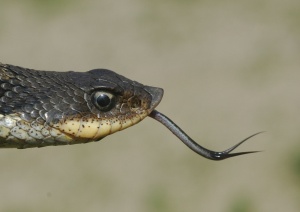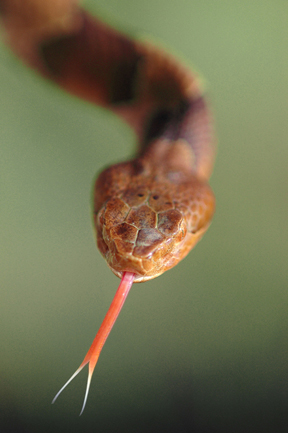Why do snakes have forked tongues?

|
This article is still under construction. Expect it to change frequently until this notice is removed. |
Contents
WHAT IS THIS PAGE?
This is the first of a series of public information pages I will be putting together to address commonly asked questions about biological issues—particularly issues and questions about vertebrate animals that I have direct or personal knowledge of. I have been motivated to create these pages because of running across web pages that purport to provide 'answers' to people's questions about animals, evolution and biology generally. While some of the answers available on the web are reasonably accurate, I have found that most are misleading or downright erroneous. The answers are usually written by people who, if good-intentioned, are mostly ignorant about the topic they are addressing. In any case, they are nearly always depending on secondary and tertiary sources of information—or worse—rather than direct knowledge or the primary literature to formulate their answers. I am both surprised by the number of people who google these queries (such as, 'why do snakes have forked tongues?') and appalled by the generally poor quality of the information they get in response, or at least, its unreliability. The aim of these pages is therefore to provide accurate, scientifically validated information on some topics in my areas of expertise that come to my attention as being of general interest.
WHO AM I?
My name is Kurt Schwenk. I am a Professor of Ecology and Evolutionary Biology at the University of Connecticut. I have a Ph.D. in zoology from the University of California, Berkeley, and did 5 years of postdoctoral training at the University of Illinois at Chicago and Harvard University before coming to UConn. My research specialty is comparative evolutionary and functional morphology of vertebrate animals, particularly lizards and snakes. In other words, I study the morphology (anatomy) of lizards, snakes and other animals and figure out how they work and how they evolved. Although I am interested in a variety of topics, my special interests are feeding systems and chemosensory systems (smell and taste). A third component of my research deals with evolutionary theory about how form and function evolve. I have almost 30 years of professional experience in this area and have published over 100 papers and edited one book. A such, I believe I qualify as an 'expert' on the topics I write about in these informational web sites.
- You can link to my professional page HERE for more information.
- You can email me directly: kurt.schwenk@uconn.edu (keep in mind that I get lots of email and am often too busy to respond promptly - though I will try)
PHOTOS, ILLUSTRATIONS AND THEIR USE
Click on photos for a larger version. All photographs and illustrations on this page are copyright (c) Kurt Schwenk. You are free to use them for non-commercial purposes (personal use, academic use), but you must ask for permission to publish them or for any commercial use. If you need a higher resolution version of a photograph, please email me, let me know how you plan to use the picture and I will send you a high-res version (kurt.schwenk@uconn.edu).
WHY DO SNAKES HAVE FORKED TONGUES? - SHORT VERSION
WHY DO SNAKES HAVE FORKED TONGUES? - LONG VERSION
SCIENTIFIC ARTICLES ON THIS TOPIC
- Schwenk, K. (1995) The serpent's tongue. Natural History 104:48-55 (April).
 POPULAR (NON-TECHNICAL) ARTICLE
POPULAR (NON-TECHNICAL) ARTICLE
- Schwenk, K. (1995) Of tongues and noses: chemoreception in lizards and snakes. Trends in Ecology & Evolution 10:7-12.

- Schulp, A. S., E. W. A. Mulder and K. Schwenk (2005) Did mosasaurs have forked tongues? Neth. J. Geosci. 84:359-371.

- Smith, C. F., K. Schwenk, R. L. Earley and G. W. Schuett (2008) Sexual size dimorphism of the tongue in a North American pitviper. Journal of Zoology 274:367-374.

- Filoramo, N., and K. Schwenk (2009) The mechanism of chemical delivery to the vomeronasal organs in squamate reptiles: a comparative morphological approach. J. Exp. Zool. 311A:20-34.


